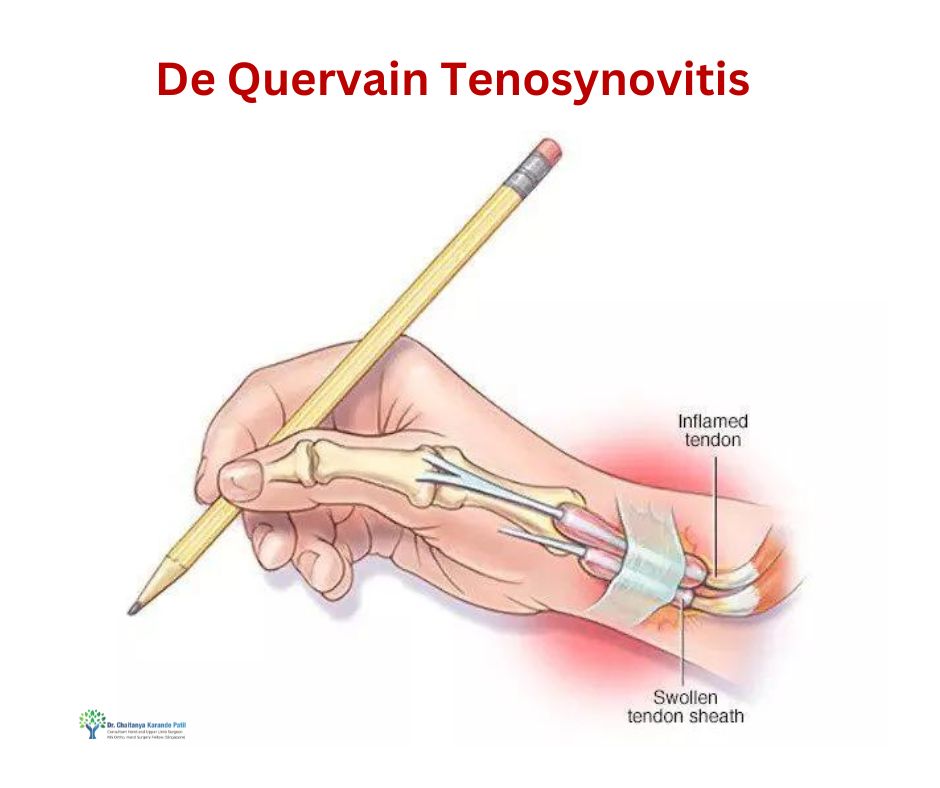De Quervain tenosynovitis

An Overview
De Quervain tenosynovitis is a condition that affects the tendons on the thumb side of the wrist, leading to pain and limited mobility. As a Hand Surgeon in Pune, Dr. Chaitanya Karande offers comprehensive diagnosis and treatment for De Quervain tenosynovitis. In this informative section, we will explore the anatomy, diagnosis, causes, and recovery options associated with this condition.
Anatomy of De Quervain Tenosynovitis
De Quervain tenosynovitis primarily involves two tendons: the extensor pollicis brevis (EPB) and the abductor pollicis longus (APL). These tendons are responsible for the movement of the thumb. The tendons run in a sheath, and any inflammation or swelling within the sheath can result in pain and discomfort.
Diagnosis of De Quervain tenosynovitis
To diagnose De Quervain tenosynovitis, Dr. Chaitanya Karande conducts a comprehensive evaluation, which may include:
Physical Examination: Dr. Chaitanya Karande examines the affected hand, assessing for swelling, tenderness, and pain in the thumb region. He may also perform specific tests, such as the Finkelstein test, to confirm the diagnosis.
Medical History: Understanding the patient’s medical history, previous injuries, and activities that may have contributed to the condition is vital in making an accurate diagnosis.
Imaging Tests: In some cases, Dr. Chaitanya Karande may recommend imaging tests such as X-rays or ultrasounds to rule out other conditions and assess the severity of the inflammation.
Causes of De Quervain Tenosynovitis
De Quervain tenosynovitis often occurs due to repetitive hand and wrist movements or activities that strain the tendons in the thumb region. Some common causes include:
- Overuse: Repetitive motions involving the thumb and wrist, such as texting, typing, or playing musical instruments, can lead to irritation and inflammation of the tendons.
- Trauma: Direct trauma or injury to the wrist, such as a fall or impact, can contribute to the development of De Quervain tenosynovitis.
- Inflammatory Conditions: Certain inflammatory conditions, such as rheumatoid arthritis, can increase the risk of developing tenosynovitis.
Recovery Options
Dr. Chaitanya Karande offers a range of treatment options to effectively manage and treat De Quervain tenosynovitis, depending on the severity of the condition. Some common recovery options include:
- Rest and Immobilization: Initially, resting the affected hand and avoiding activities that aggravate the condition may help alleviate symptoms. Immobilization using a splint or brace may also be recommended to allow the tendons to heal.
- Medications: Nonsteroidal anti-inflammatory drugs (NSAIDs) can help reduce pain and inflammation associated with De Quervain tenosynovitis.
- Physical Therapy: Under the guidance of Dr. Karande, a customized physical therapy program may be designed to improve the range of motion, strength, and flexibility of the affected hand and wrist.
- Corticosteroid Injections: In cases of severe pain and inflammation, Dr. Karande may administer corticosteroid injections directly into the affected sheath to provide relief.
- Surgical Intervention: If conservative treatments do not provide adequate relief, Dr. Karande may recommend surgery. The surgical procedure involves releasing the constricted sheath to allow the tendons to move freely.
Conclusion
If you are experiencing pain, swelling, or limited mobility in the thumb and wrist region, De Quervain tenosynovitis may be the cause. Consulting with a specialized Hand Surgeon in Pune, such as Dr. Chaitanya Karande, can help in accurate diagnosis and effective treatment of this condition. With a comprehensive understanding of the anatomy, diagnosis, causes, and recovery options associated with De Quervain tenosynovitis, Dr. Chaitanya Karande provides personalized care to promote healing, alleviate symptoms, and restore optimal hand functionality.
